As animals do not have chlorophyll, they can’t prepare their food own. They obtain their food directly or indirectly from plants. Animals may be herbivores, carnivores or omnivores.
In this type of nutrition, animals take in solid food such as fruits, vegetable & meat, etc.
Five steps in the process of holozoic nutrition in animals. are -
(1) Ingestion
(2) Digestion
(3) Absorption
(4) Assimilation
(5) Egestion
NUTRITION IN AMOEBA : Amoeba is a unicellular animal. It eats microscopic plants & animals that float in water.
The complete process of nutrition in amoeba is as follows -
(1) Ingestion : An amoeba ingests food by using its pseudopodia. When a food particles comes near an amoeba, it ingests this food particle by surrounding it with its pseudopodia. The pseudopodia close to form a small cavity called food vacuole.
(2) Digestion : The food is digested in the food vacuole by digestive enzymes.
(3) Absorption : The digested food present in the food vacuole is absorbed directly into the cytoplasm of amoeba by diffusion. The digested food just spreads out from the food vacuole into the cytoplasm of amoeba cell.
(4) Assimilation : Food absorbed by amoeba is used to obtain energy for maintaining life process.
(5) Egestion : When a sufficient amount of undigested food collects inside amoeba, then its cell membrane suddenly ruptures at any place & the undigested food is thrown of the cell.

(1) Nutrition in human is holozoic. The food ingested through the mouth passes through a number of organ in our body which constitute the alimentary canal.
(2) The alimentary canal along with digestive glands known as digesttive system.
(3) The digestive system of human consists of following organs -
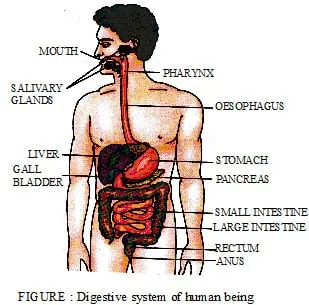
(i) Mouth : It is a transvers slit & also called opening of alimentary canal. Mouth opens into buccle cavity.
(ii) Buccle cavity : Mouth open into a cavity which contain teeth, tongue & salivary glands. Salivary glands secrete saliva which contain salivary amylase enzyme & convert the starch into simple sugar.
(iii) Teeth : Teeth are hard structures held in sockets of the jaws. Teeth cut, chew and break food into smaller pieces.
Jaws present in buccal cavity are provided with four different types of teeth:
(a) Incisors : For cutting
(b) Canines : For tearing
(c) Premolars : For grinding
(d) Molars : For grinding
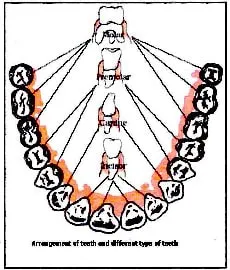
(iv) Tongue : Tongue is the organ used for taste. It contains taste buds to distinguish whether a type of food is sweet, sour, bitter or hot (figure). It also helps in rolling and pushing the food into the pharynx. It mixes the saliva with the food and also helps us in speaking.
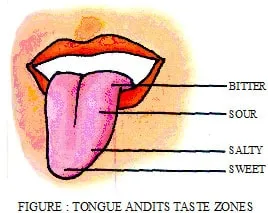
(v) Oesophagus or Food Pipes : It is a connecting tube between the mouth and stomach. The food is pushed down towards the stomach by the movement of the muscles of the food pipe.
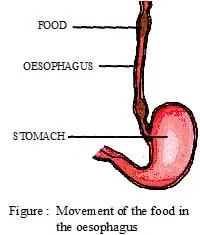
(vi) Stomach : Stomach is a J-shaped bag-like structure made of muscles. The stomach secretes gastric juice and hydrochloric acid. Hydrochloric acid kills microorganisms and provides an acidic medium for effective digestion.
In the stomach food is throughly mixed with the gastric juice secreted by the gastric glands present in the stomach. The gastric juice contians an enzyme called pepsin which helps to break down proteins into simpler substances.
Ruminant Stomach: Ruminants have a large compound stomach. The ruminants are mammals that “chew the cud”. They include cattle, buffaloes, goats, sheep, deer and camels. The stomach of first four mammals consists of 4 chambers: Rumen (paunch), Reticulum (honeycomb), Omasum (psalterium) and Abomasum (rennet). Rumen is the largest chamber and receives the oesophagus. Abomasum leads into the duodenum through the pyloric valve. In the rumen, food undergoes mechanical and chemcial breakdown.
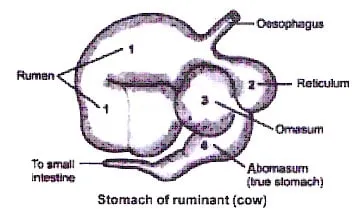
(vii) Small Intestine : It is a coiled tube and is about 7 metres in length. It consists of three parts, namely dueodenum, jejunum and ileum. In the small intestine the food is mixed with bile juice and pancreatic juice. These are secreted by the liver and the pancreas, respectively. Bile juice breaks down fats into fatty acids and glycerol. The pancreatic juice breaks down starch into simple sugar and proteins into amino acids. Digestion of all the components of food gets completed here and the end products are ready for absorption.
Absorption of food occurs through millions of small projections in the inner walls of the part of small intestine called ileum. These projections are known as villi. The incorporation of absorbed nutrients into the cell components is called assimilation.
The food that remains undigested and unabsorbed then enters the large intestine.
(viii) Large intestine : It is the last organ of the digestive system. It is about 1.5 m in length. It consists of three parts, namely caecum, colon and rectum. It helps in absorbing water and in removing undigested solid wastes from the body in the form of faeces through an opening called anus.
(ix) Anus : It is the last part of the alimentary canal. Its main function is to expel solid faceces out of the body.
(x) Digestive Glands :
(a) Salivary Glands : There are three pairs of salivary glands located in the mouth. Salivary glands secrete saliva which contains amylase enzyme. Amylase works on starch and converts it into simple sugar.
(b) Liver : It is reddish brown gland and is located in the upper part of the abdomen. It secretes bile juice that is stored in gallbladder. The bile helps in breaking down fat into simpler substances.
(c) Pancreas : It is a cream-coloured gland and is located just below the stomach. It secretes pancreatic juice into a small intestine. It acts on carbohydrates and protein and converts them into simpler substances.
NUTRITION IN A RUMINANT
A ruminant is an herbivours animal which regurgitates its food & digest it in step. For example- Cow, goats, sheep etc.
The 2 steps involved in digestion of ruminants are -
(1) The ruminant first eats the foods & regurgitates a semi digested food called cud.
(2) The ruminant then eats the cud when at rest. This process of eating the cud is called ruminating.
Ruminants have a special stomach with 4 chambers, which are as follows -
(a) Rumen : This is the largest chamber of the stomach. It is namely used for storing food.
(b) Reticulum : It helps in moving the food bakc to the mouth when needed.
(c) Omasum : This is the smallest chamber of the stomach. Its main function is to absorb excess water.
(d) Abomasum : This is a true stomach where gastric juices are secreted to help digestion. Here the food is digested just like in the human stomach.
Disgestion of food in ruminants :
The ruminants mostly eat grasses and leaves which are rich in cellulose, The ruminants can digest cellulose becuase celluose-digesting bacteria and protozoa are present in their stomach.
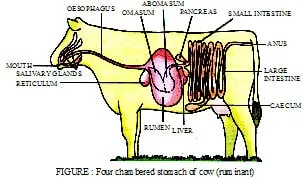
Half-chewed grass travels from the mouth to the first chamber of the stomach called rumen where it is acted upon by bacteria and microorganism. It then goes into the reticulum from where it is returned to the mouth as cud for through chewing called rumination. It enters a third chamber called omasum. Here it is broken down into still smaller pieces. Finally, it enters the fourth chmaber called abomasum where enzymes act upon it and digestion is completed. It is finally sent to the small intestine where the absorption of the nutrients takes place.
UNSOLVED PROBLEMS
Q.1 Name the organs that make the alimentary canal.
Q.2 What is the role of hydrochloric acid in the stomach ?
Q.3 Why do we call animals heterotrophs ?
Q.4 What is the function of villi ?
Q.5 What happens to digested food after absorption?
Q.6 How does an amoeba capture its food ?
Q.7 What are villi ? What is their location and function ?
Q.8 What is the juice secreted by the liver called ? What does it do ?
Q.9 What happens to food in the small intestine ?
Q.10 What is pancreas and where is it located ?
Q.11 Draw a diagram of the tongue to show the location of various taste buds.
Q.12 Which digestive juice is secreted in the mouth? What enzyme does it contain and what is its function ?
Q.13 Draw a labelled digram of the alimentary cannal of humans.
Q.14 What is the role of stomach in the digestion process ?
Q.15 What happens to the food in the small intestine?
OLYMPIAD PROBLEMS
1. Digestion within a digestive tract is -
(A) incomplete
(B) extracellular
(C) the same as absorption
(D) an irreversible process
2. Which of the following regions of the alimentary canal of man does not secrete a digestive enzyme ?
(A) Oesophagus (B) Stomach
(C) Duodenum (D) Mouth
3. A digestive enzyme, salivary amylase, in the saliva begin digestion of -
(A) protein (B) nucleic acids
(C) facts (D) carbohydrates
4. If you chew on a piece of bread long enough, it will begin to taste sweet because -
(A) maltase is breaking down maltose
(B) lipases are forming fatty acids
(C) amylase is breaking down starches to disaccharides
(D) disaccharides are forming glucose
5. Saliva has the enzyme -
(A) pepsin (B) ptyalin
(C) trypsin (D) rennin
6. Pepsin digests -
(A) proteins in stomach
(B) carbohydrates in duodenum
(C) proteins in duodenum
(D) fats in ileum
7. Cheif function of HCl is -
(A) to maintain a low pH to prevent growth of micro-organisms
(B) to facilitate absorption
(C) to maintain low pH to activate peptinogen to form pepsin
(D) to dissolve enzyme secreted in stomach
8. If the stomach did not produce any hydrochloric acid, which enzyme will not function ?
(A) Ptyalin (B) Trypsin
(C) Pepsin (D) Collagenase
9. Cheif function of bile is -
(A) to digest fat by enzymatic action
(B) to emulsify fat for digestion
(C) to eliminate waste product
(D) to regulate process of digestion
10. Ileum is -
(A) First part of the small intestine
(B) Middle part of the small intestine
(C) Last part of the small intestine
(D) Not a part of the small intestine
11. Where is bile produced ?
(A) In gall bladder (B) In blood
(C) In liver (D) In spleen
12. Largest gland in human body is -
(A) liver (B) pancreas
(C) pituitary (D) thyroid
13. The part of digestive system which helps in mixing food with saliva is -
(A) teeth (B) oesophagus
(C) tongue (D) lips
14. Which of the following is not a part of nutrition-
(A) digestion (B) absorption
(C) excretion (D) assimilation
15. Which of the organs produces bile ?
(A) liver (B) pancreas
(C) gallbladder (D) gastric gland
16. An amoeba ingests food by -
(A) cilia (B) tentacles
(C) pseudopodia (D) feeding tube
17. The walls of the large intestine absorb -
(A) cellulose (B) water
(C) digested food (D) digested proteins
18. Small intestine have this to increase the surface area for absorption -
(A) villi (B) glands
(C) liver (D) pancreas
19. Juice secreated by liver is -
(A) bile (B) gastric
(C) pancreatic (D) acid
20. Number of chambers in the stomach of ruminats is -
(A) 4 (B) 3 (C) 2 (D) 1
21. Fat is completely digested in the
(A) Stomach (B) Mouth (C) Small intestine (D) Large intestine
22. Water and salts from the undigested food is absorbed mainly in :
(A) Stomach (B) Food pipe (C) Mouth (D) Large intestine
23. No. of salivary glands in human beings is/are:
(A) One pair (B) Two pairs (C) Three pairs (D) Four pairs
24. Vitamin that can be synthesized by solar energy is:
(A) A (B) B (C) C (D) D
25. Villi are situated in :
(A) Small intestine (B) Large intestine (C) Both (A) , (B) (D) Stomach
26. Cud chewing animals are known as :
(A) Frugivores (B) Sangunivores (C) Ruminants (D) Cannibals
27. Number of teeth which grow twice are :
(A) 8 (B) 14 (C) 12 (D) 20
28. Vitamin C helps in :
(A)Vision (B) Healthy skin (C) Wound healing (D) None of these
29. Most abundant organic compound on earth is :
(A) Protein (B) Cellulose (C) Lipids (D) Fat
30. In ruminants bacterial action take places in :
(A) Rumen (B) Food pipe (C) Intestine (D) All of the above
31. Which of the following is not a function of vitamins :
(A) Digestion (B) Metabolism (C) Growth (D) None of these
32. Vitamin that helps in normal vision is :
(A) A (B) B (C) C (D) E
33. Amoeba is :
(A) Unicellular (B) Multicellular (C) Microscopic (D) (A), (C) both
34. Partially digested food in rumen of ruminants is called :
(A) Cud (B) Curd (C) Chyme (D) Chyle
35. Cellulose is a kind of :
(A) Carbohydrates (B) Protein (C) Fat (D) Vitamins
36. Diarrhoea occurs due to :
(A) Infection (B) Food poisoning (C) Indigestion (D) All of the above
37. Largest digestive gland of body is :
(A) Liver (B) Pancreas (C) Salivary gland (D) All of the above
38. No. of teeth that appears once in life time are
(A) 22 (B) 32 (C) 20 (D) 12
39. Human digestive system could not digest :
(A) Complex proteins (B) Cellulose (C) Fats (D) All of these
40. Pseudopodia of Amoeba helps in :
(A) Movements (B) Food intake (C) Both (A), (B) (D) Growth
41. The end product of fat digestion is -
(A) Glucose (B) Fatty acids & glycerol (C) Amino acids (D) Alkaloids
42. The action of bile can be called -
(A) Oxidation
(B) Emulsification
(C) Esterification
(D) Dehydrogenation
43. Which set is mixed with the food in small intestine ?
(A) Saliva, gastric juice, bile
(B) Gastric juice, bile, pancreatic juice
(C) Bile, pancreatic juice, succus entericus
(D) Bile, pancreatic juice and saliva
44. A good source of lipase is -
(A) Saliva (B) Gastric juice (C) Bile (D) Pancreatic juice
45. Enzymes required for digestion of fat is -
(A) Amylase (B) Trypsin (C) Pepsin (D) Lipase
46. Ptyalin is an enzyme present in -
(A) Gastric juice (B) Pancreatic juice (C) Intestinal juice (D) Saliva
47. Which one does not produce any digestive enzyme?
(A) Pancreas (B) Liver (C) Stomach (D) Duodenum
48. The number of salivary glands present in human beings is -
(A) 5 pairs (B) 4 pairs (C) 3 pairs (D) 2 pairs
49. Largest gland in the body is -
(A) Liver (B) Pancreas (C) Gastric gland (D) Adrenal
50. Which of the following has no digestive enzyme?
(A) Saliva (B) Bile (C) Gastric juice (D) Intestinal juice
51. The main organ for digestion and absorption of food is -
(A) large intestine (B) small intestine (C) stomach (D) liver
52. Liver helps in -
(A) Digestion of food
(B) Detoxification
(C) Secretion
(D) All of these
53. Food pipe is the another name of -
(A) Oesophagus (B) Bile duct (C) Salivary gland (D) Pancreatic duct
54. Total number of cannines in permanent dental set of human is -
(A) 4 (B) 6 (C) 2 (D) 12
55. Starch is digested by -
(A) Peptidase (B) Amylase (C) Lipase (D) Proteinase
56. Bile is produced by -
(A) Stomach (B) Liver (C) Gall bladder (D) Pancreas
57. The liver stores food in the form of
(A) glucose (B) glycogen (C) albumen (D) ATP
58. Vermiform appendix is a part of
(A) alimentary canal
(B) nervous system
(C) vascular system
(D) reproductive system
59. Completion of digestion occurs in -
(A) stomach (B) large intestine (C) liver (D) small intestine
60. Wisdom teeth in man are
(A) incisor (B) canine (C) last molars (D) all of these
61. Digestion is
(A) conversion of large food particles into small food particles
(B) conversion of small food particles into large food particles
(C) conversion of food into protoplasm
(D) conversion of non-diffusible food particles into diffusible food
62. Muscular contractions of alimentary canal are
(A) circulation (B) deglutition
(C) peristalsis (D) churning
63. Which of the following regions of the alimentary canal of man does not secrete a digestive enzyme?
(A) Oesophagus (B) Stomach
(C) Duodenum (D) Mouth
64. The incisor tooth is meant for
(A) biting and cutting
(B) chewing
(C) munching and chewing
(D) munching
65. A bolus is
(A) a mass of crushed food moistened with saliva
(B) the semisolid material resulting from partial digestion in the stomach
(C) the milky emulsified fat absorbed from small intestine
(D)indigestible materials that helps in movement and absorption
66. Saliva has the enzyme
(A) pepsin (B) ptyalin
(C) trypsin (D) rennin
67. Curdling of milk in the stomach is due to the action of
(A) pepsin (B) rennin
(C) HCl (D) renin
68. Chief function of HCl is
(A) to maintain a low pH to prevent growth of micro-organisms
(B) to facilitate absorption
(C) to maintain low pH to activate pepsinogen to form pepsin
(D) to dissolve enzyme secreted in stomach
69. Bile is produced and stored by
(A) produced and stored by gall bladder
(B) produced and stored by liver
(C) produced in liver and stored in gall bladder
(D) produced in gall bladder and stored in liver
70. Ileum is
(A) first part of the small intestine
(B) middle part of the small intestine
(C) last part of the small intestine
(D) not a part of the small intestine
Section-A
• Fill in the blanks
1. The largest gland in the human body is __________.
2. No. of milk teeth in human body is __________.
3. The stomach release hydrochloric acid and __________ juices which act on food.
4. __________ is the false feet of Amoeba.
5. Amoeba digests its food in the __________.
6. __________ helps in cellulose digestion in Ruminants.
7. Cellulose is a __________.
8. __________ cannot be digested by human alimentary canal.
9. ORS is given to prevent __________.
10. Bile is secreted by __________, which help in digestion of __________.
11. Digested food is absorbed in __________ with the help of __________.
12. Working of stomach is observed by __________.
13. Removal of faecal matter from anus is called __________.
14. Saliva helps in break down of __________.
15. Intake of food is called __________.
Section-B
• Write true of false or following statements:
16. Digestion of fat occurs in stomach.
17. The tongue helps in mixing food with saliva.
18. The gall bladder store bile.
19. The ruminants bring back swallowed grass into their mouth and chew it for some time.
20. Bile lacks digestive enzyme.
21. No digestion occurs in oesophagus.
22. Amino acids are end products of Fat digestion.
23. Large intestine helps in sugar absorption.
24. Partially digested food in rumen is called chyme.
25. Process of digestion is completed in small intestine.
Section-C
26. Plaque is:
(A) hard, protective covering on the tooth
(B) soft covering of the tooth whichis present below the visible part
(C) the cavity which contains nerves and blood vessels in a tooth
(D) Sticky film of food, saliva and bacteria near the gums
27. Dentine is :
(A) hard, protective covering on the
tooth
(B) the cavity which contains nerves and blood vessels in a tooth
(C) the soft, invisible covering present in a tooth
(D) the nerve that connects tooth and the brain
28. The study of teeth is called :
(A) dentistry (B) dermatology
(C) neurology (D) cardiology
29. The cavity present in the tooth is called:
(A) pulp cavity
(B) nasal cavity
(C) abdominal cavity
(D) chest cavity
30. For healthy teeth and bones the fol- lowing mineral is required:
(A) iron (B) calcium
(C) sodium (D) magnesium
31. Blood vessels and nerves of a tooth are present in :
(A) pulp cavity
(B) dentine
(C) crown of a tooth
(D) enamel
32. Amoeba procures food through
(A) proboscis (B) pseudopodia
(C) cilia (D) tongue
33. Pseudopodia are
(A) Wise feet developed in some unicellular organisms
(B) small hairlike structures present on the unicellular organisms
(C) a long, tube like structure coming out of the mouth
(D) suckers which are attached to the walls of intestines
34. The process of taking in food from the environment is called
(A) ingestion (B) digestion (C) assimilation (D) nutrition
35. Enzymes are
(A) substances which are broken into simpler substances during digestion
(B) substances which are made by the combination of carbohydrates
(C) substances which break complex food molecules into simpler food molecules
(D) substances which break complex substances and they themselves undergo dissociation reactions
36. Assimilation is
(A) the process of breaking large food molecules into simpler molecules
(B) the process by which undigested food is ejected out of the body
(C) the process by which the digested food carried by the blood is taken in by the cells of the body
(D) process of inter-exchange of oxygen and carbon dioxide between haemoglobin and the cells of the body
37. The digestion of food in amoeba is
(A) intracellular (B) intercellular
(C) intravenous (D) none of these
38. The tube starting at mouth and ending at anus is called
(A) oesophagus
(B) food cavity
(C) alimentary canal
(D) elementary canal
39. Food absorbed through
(A) villi (B) blood
(C) blood platelets (D) amylase
40. Large intestine absorbs
(A) digested food
(B) undigested food
(C) water
(D) remaining enzymes
41. The undigested, semisolid food is called
(A) anus (B) faeces
(C) rectum (D) villi
42. The function of hydrochloric acid in
the stomach is
(A) to digest carbohydrates
(B) to clean the stomach
(C) to kill the germs
(D) to break down proteins
43. The longest part of the alimentary canal is
(A) oesophagus (B) large intestine
(C) small intestine (D) stomach
44. Most of the digestion and absorption
of the food takes place in
(A) stomach (B) liver
(C) small intestine (D) large intestine
45. Bile is secreted by
(A) stomach (B) small intestine
(C) pancreas (D) liver
46. The digestion taking place in small intestine is
(A) intracellular (B) extracellular
(C) both (D) none
47. Various steps of human nutrition are in the order
(A) ingestion, egestion, digestion, absorption and assimilation
(B) ingestion, egestion, assimilation, absorption and assimilation
(C) ingestion, assimilation, digest-ion, absorption and egestion
(D) ingestion, digestion, absorption,
assimilation and egestion
48. Digestion starts and ends from
(A) mouth to small intestine
(B) mouth to large intestine
(C) mouth to anus
(D) mouth to rectum
49. The salivary glands secrete
(A) amylase (B) pepsin
(C) trypsin (D) bile juice
50. The process of breaking down food chewing is called
(A) digestion (B) assimilation
(C) salivation (D) mastication
51. The glands situated around the mouth that secrete amylase enzyme are called
(A) salivary glands
(B) pituitary glands
(C) hypothalamus glands
(D) extracellular glands
52. The part of alimentary canal that runs from the mouth to stomach is called
(A) trachea (B) bronchi
(C) oesopagus (D) intestine
53. Peristalsis is
(A) wearing out of colour on the parts of leaves due to lack of carbon dioxide and chlorophyll
(B) process of breakdown of large food molecules into simpler molecules by the amylase enzyme
(C) movement of food through alimentary canal by the wavelike movement controlled by involuntary muscles
(D) process by which digested food is carried by the blood to different cells in the body
54. Stomach secretes
(A) dilute hydrochloric acid
(B) dilute sulphuric acid
(C) dilute citric acid
(D) dilute nitric acid
55. Glands in the walls of the stomach secrete an enzyme called
(A) amylase (B) trypsin
(C) pepsin (D) serotonin
56. In the above diagram, the teeth marked II represent
(A) incisors
(B) canines
(C) molars
(D) premolars
57. Teeth marked I represent
(A) incisors (B) canines
(C) molars (D) premolars
58. The teeth used to grind are marked as
(A) I (B) II
(C) III (D) IV
59. Teeth marked III are also called
(A) cracking teeth
(B) molars
(C) tearing teeth
(D) canines
60. Match the following
1. Incisors a. Grinding teeth
2. Canines b. Cracking teeth
3. Premolars c. Cutting teeth
4. Molars d. Tearing teeth
(A) 1 – d, 2-d, 3-a, 4-c
(B) 1-b, 2-a, 3-d, 4-c
(C) 1-c, 2-b, 3-d, 4-a
(D) 1-c, 2-d, 3-b, 4-a
61. An adult has …….. teeth.
(A) 20 (B) 24
(C) 28 (D) 32
62. Which of the following is not true for the are of teeth?
(A) We should not chew the food
(B) We should not eat too many sweets
(C) We should brush twice a day
(D) We should eat raw fruits and vegetables
63. Which of the following is a soft material in the teeth?
(A) Dentine (B) Pulp
(C) Enamel (D) Root
64. The outer portion of the tooth is called.
(A) crown (B) root
(B) enamel (D) pulp
65. Which of the following correctly represents the passage of food in our body?
(A) Mouth (B) Mouth
Stomach Food pipe
Food pipe Stomach
Small intestine Small intestine
(C) Mouth (D) Mouth
Stomach Small intestine
Small intestine Food pipe
Food pipe Stomach
66. Which of the following is not a good habit?
(A) Washing our hands before eating food
(B) Eating regularly at the same time in a day
(C) Swallowing the food without chewing it
(D) Eating fresh and warm food
67. Our stomach expands when the food enters and contracts when it goes out. Thus the stomach can expand and contract. This is possible because our stomach is made of
(A) bones (B) muscles
(C) blood (D) iron
68. The soft, sticky layer formed on the
tooth which is harmful is
(A) Enamel (B) Plaque
(C) Dentine (D) Pulp
69. Fill the blank.
Sugar + Plaque
(A) Starch (B) Enamel
(C) Acids (D) Microbes
70. Our stomach is located
(A) in the head
(B) in the left side of the body
(C) in the right side of the body
(D) below the abdomen
71. The inner layer of the stomach releases
(A) water
(B) blood
(C) minerals
(D) digestive juices
72. Digested food is absorbed by
(A) heart (B) lungs
(C) blood (D) water
73. Raju got stomachache. Which of the following could be a reason?
(A) He ate food at seven in the evening
(B) He drank water after eating food
(C) He did not ‘chew the food properly
(D) He did not wash his hands properly after eating food
74. Which of the following animal pops out its stomach through mouth?
(A) Snail (B) Hydra
(C) Star fish (D) Amoeba
75. Which of the following have taste suds?
(A) Palate
(B) Mucous lining
(C) Tongue
(D) None of
76. Why do we get hiccups while eating?
(A) Due to spicy food
(B) Food particles enter the wind pipe
(C) Food particles enter the food pipe
(D) Any infection in throat
77. Which of the following is the stomach part in which herbivores secretes the grass which is swallowed quickly.
(A) Lumen
(B) Pyloric
(C) Rumen
(D) lleum
78. Which of the following diseases shows the symptoms of watery stool frequently?
(A) Jaundice
(B) Malaria
(C) Diarrhoea
(D) None of these
79. Partially digested food in ruminants is
(A) Chyme (B) Cud
(C) Bolus (D) All of these
80. ln Amoeba which of the following helps in digestion.
(A) Pseudopodia
(B) Cytoplasm
(C) Nucleus
(D) Vacuole
ANSWER KEY
EXERCISE-II
1. D 2. A 3. D 4. A 5. B 6. A 7. C
8. C 9. B 10. C 11. C 12. A 13. C 14. C
15. A 16. C 17. B 18. A 19. A 20. A 21. C
22. D 23. C 24. D 25. A 26. C 27. D 28. C
29. B 30. A 31. A 32. A 33. D 34. A 35. A
36. D 37. A 38. D 39. B 40. C 41 B 42. B
43. C 44. D 45. D 46. D 47. B 48. C 49. A
50. B 51. B 52. D 53. A 54. A 55. B 56. B
57. B 58. A 59. D 60. C 61. D 62. C 63. A
64. A 65. A 66. B 67. B 68. C 69. C 70. C
EXERCISE-III
Section-A
1. liver 2. 20 3. Gastric
4. Pseudopodia 5. Food vacuole 6. Caecum
7. Carbohydrate 8. Cellulose 9. Diarrhoea
10. Liver, fat 11. Small intestine, villi 12. Beaumont
13. Egestion 14. Starch 15. Ingestion
Section-B
16. (F) 17. (T) 18. (T) 19. (T) 20. (T)
21. (T) 22. (F) 23. (F) 24. (F) 25. (T)
Section-C
26. D 27. C 28. A 29. A 30. B 31. A 32. B
33. A 34. A 35. C 36. C 37. A 38. A 39. A
40. C 41. B 42. C 43. C 44. C 45. D 46. B
47. D 48. A 49. A 50. D 51. A 52. C 53. C
54. A 55. C 56. B 57. A 58. D 59. A 60. D
61. D 62. A 63. B 64. A 65. B 66 C 67. B
68. C 69. C 70. B 71. C 72. C 73. C 74. C
75. C 76. B 77. C 78. C,A 79. B 80. D